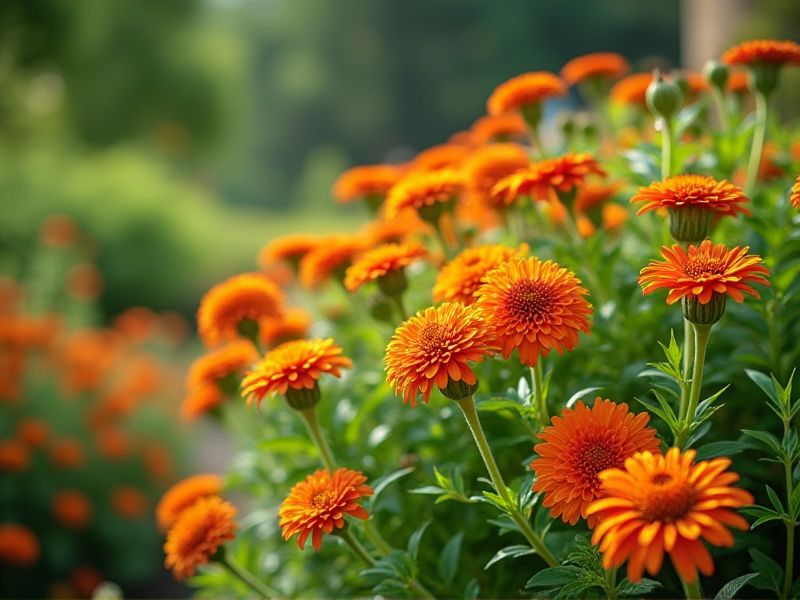
Drought-resistant ornamental plants thrive in arid conditions, making them ideal for sustainable landscaping. Species like succulents, lavender, and ornamental grasses offer vibrant colors and textures while requiring minimal water. These plants often feature adaptations such as thickened leaves or deep root systems to conserve moisture. In gardens, incorporating drought-resistant varieties not only reduces water usage but also creates a visually appealing environment. For your landscaping, consider selecting native drought-tolerant species to enhance biodiversity and support local ecosystems.
List of some Ornamental plants that are drought-resistant
- Lavender (Lavandula)
- Agave (Agave americana)
- Russian Sage (Perovskia atriplicifolia)
- Sedum (Sedum spp.)
- Bougainvillea (Bougainvillea spectabilis)
- Oleander (Nerium oleander)
- Yucca (Yucca spp.)
- Lantana (Lantana camara)
- Blanket Flower (Gaillardia x grandiflora)
- Rosemary (Rosmarinus officinalis)
Important things about Ornamental plants that are drought-resistant
Definition Of Drought-Resistant Ornamental Plants
Drought-resistant ornamental plants are specially selected varieties that can thrive in low-water environments, making them ideal for sustainable gardens and xeriscapes. These plants typically possess adaptations such as deep root systems, succulent foliage, or waxy coatings that help retain moisture. Popular choices include succulents like Agave and Echeveria, as well as native grasses and perennials such as Lavender and Salvia, which not only conserve water but also enhance the aesthetic appeal of your landscape. Selecting drought-resistant ornamental plants contributes to water conservation and supports biodiversity, while offering vibrant colors and textures in your garden.
Types Of Drought-Resistant Ornamental Plants
Drought-resistant ornamental plants such as succulents, agaves, and ornamental grasses are ideal for conserving water while enhancing your garden's aesthetics. Succulents like Aloe Vera and Echeveria store moisture in their leaves, making them low-maintenance options for dry climates. Agaves, with their striking rosette form and sculptural appearance, thrive in arid conditions and require minimal irrigation once established. Incorporating these plants not only reduces water usage but also promotes a sustainable and visually appealing landscape.
Benefits Of Drought-Resistant Plants
Drought-resistant ornamental plants, such as succulents and native perennials, offer both aesthetic appeal and water conservation benefits. By incorporating species like lavender or agave into your garden, you can enhance visual diversity while significantly reducing irrigation needs. These plants are not only resilient to prolonged dry conditions but also attract beneficial pollinators, boosting local biodiversity. Choosing drought-tolerant plants allows you to create a sustainable landscape that flourishes with minimal water input.
Soil Requirements For Drought-Resistant Plants
Drought-resistant ornamental plants thrive in well-draining soil that allows for efficient water management, ensuring that excess moisture does not lead to root rot. Ideal soil should be sandy or loamy with organic matter to improve moisture retention while providing essential nutrients. Incorporating mulch around the plants can further enhance soil structure, protect roots, and reduce evaporation. When selecting plants, consider native species, as they are often well-adapted to local conditions and require minimal irrigation.
Watering Needs During Establishment
Watering is crucial for the establishment of drought-resistant ornamental plants, especially during their first growing season. This period usually requires deep watering techniques, allowing moisture to penetrate the root zone effectively, encouraging strong root development. Consistent, moderate irrigation fosters resilience against future drought conditions by helping plants access nutrients and establishing robust systems for water conservation. As these plants acclimate, reducing watering frequency will enhance their ability to thrive in dry conditions with minimal intervention.
Ideal Blooming Seasons For Drought-Resistant Plants
Drought-resistant ornamental plants thrive during specific blooming seasons that enhance their aesthetic value while requiring minimal water. Species like lavender and salvia often bloom in late spring and early summer, showcasing vibrant colors and attracting pollinators. In the fall, ornamental grasses such as Purple Fountain Grass and Little Bluestem exhibit striking colors and textures, providing visual interest while conserving moisture. Incorporating these plants into your landscape not only creates a resilient garden but also contributes to biodiversity and sustainability.
Maintenance Practices For Drought-Resistant Gardens
Drought-resistant ornamental plants, such as succulents, lavender, and ornamental grasses, thrive in arid conditions while adding beauty to your garden. Implementing deep watering techniques encourages deep root growth, allowing these plants to access moisture from lower soil layers. Mulching around plants helps retain soil moisture and suppresses weeds, which can compete for limited water resources. Regularly monitoring soil moisture levels ensures your drought-resistant garden remains hydrated in essential areas without overwatering, promoting a sustainable environment.
Common Pests And Diseases
Drought-resistant ornamental plants, such as Mediterranean herbs, succulents, and native wildflowers, often face specific pests and diseases that can hinder their growth. Aphids, spider mites, and mealybugs are common pests that may infest these plants, leading to weakened vitality and aesthetic appeal. Fungal diseases like powdery mildew and root rot can occur, especially in plants with poor air circulation or excessive watering, making it crucial for you to monitor moisture levels. Implementing integrated pest management strategies, including natural predators and organic fungicides, can help protect your resilient garden from these threats.
Companion Plantings For Drought-Resistant Varieties
Companion plantings can significantly enhance the resilience of drought-resistant ornamental plants. For instance, pairing succulents with native grasses creates a visually appealing landscape while minimizing water usage. You can also consider planting lavender alongside stonecrop to attract pollinators and provide a fragrant touch without demanding excessive irrigation. Implementing these combinations not only conserves water but also enriches biodiversity in your garden space, promoting a sustainable ecosystem.
Landscape Design Tips With Drought-Resistant Plants
Incorporating drought-resistant ornamental plants into your landscape design can greatly enhance both aesthetics and sustainability. Species like Agave, Lavender, and Sedum not only thrive in arid conditions but also offer diverse textures and vibrant colors, making your garden visually striking year-round. Selecting native plants, such as California poppy or succulents, can further minimize water usage while supporting local ecosystems. Consider using mulch to retain soil moisture and reduce evaporation, ensuring your ornamental plants flourish even in dry spells.
